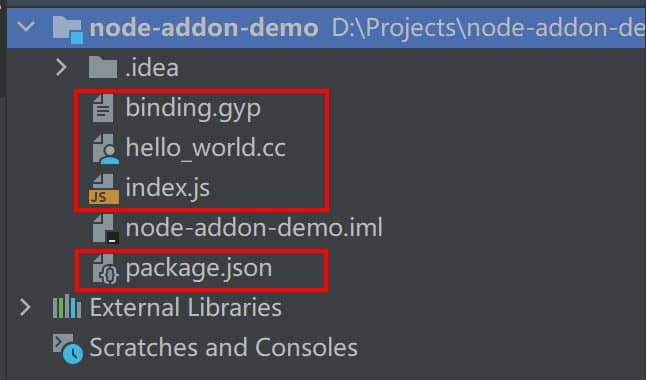使用node-gyp编写简单的node原生模块
通过样例,让我们了解如何编写一个node的原生模块。当然,这篇文章还有一个目的,是为了方便以后编写关于node-gyp的文章,搭建初始环境。
基于node-addon-api
基于node-addon-api的nodejs插件,使用的是node的头文件:#include <node.h>。
hello_world.cc
#include <node.h>
void Method(const v8::FunctionCallbackInfo<v8::Value>& args) {
v8::Isolate* isolate = args.GetIsolate();
args.GetReturnValue().Set(v8::String::NewFromUtf8(
isolate, "world").ToLocalChecked());
}
void Initialize(v8::Local<v8::Object> exports) {
NODE_SET_METHOD(exports, "hello", Method);
}
NODE_MODULE(NODE_GYP_MODULE_NAME, Initialize)
binding.gyp
{
"targets": [
{
"target_name": "hello_world",
"sources": [ "hello_world.cc" ]
}
]
}
index.js
const binding = require('./build/Release/hello_world');
console.log(binding.hello());
package.json
...
"scripts": {
"build": "node-gyp configure && node-gyp build",
"run:demo": "node index.js"
},
...
整体结构

按照如下命令依次运行:
$ npm run build
// 使用node-gyp配置并构建
$ npm run run:demo
// 运行Demo
输出如下:
D:\Projects\node-addon-demo>npm run run:demo
> node-addon-demo@1.0.0 run:demo
> node index.js
world
附上GitHub地址:w4ngzhen/node-addon-demo (github.com),方便以后快速完成环境搭建。





【推荐】国内首个AI IDE,深度理解中文开发场景,立即下载体验Trae
【推荐】编程新体验,更懂你的AI,立即体验豆包MarsCode编程助手
【推荐】抖音旗下AI助手豆包,你的智能百科全书,全免费不限次数
【推荐】轻量又高性能的 SSH 工具 IShell:AI 加持,快人一步
· SQL Server 2025 AI相关能力初探
· Linux系列:如何用 C#调用 C方法造成内存泄露
· AI与.NET技术实操系列(二):开始使用ML.NET
· 记一次.NET内存居高不下排查解决与启示
· 探究高空视频全景AR技术的实现原理
· 阿里最新开源QwQ-32B,效果媲美deepseek-r1满血版,部署成本又又又降低了!
· 单线程的Redis速度为什么快?
· SQL Server 2025 AI相关能力初探
· AI编程工具终极对决:字节Trae VS Cursor,谁才是开发者新宠?
· 展开说说关于C#中ORM框架的用法!